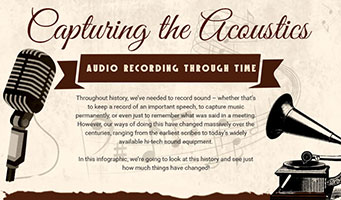Audio Recording Through the Ages: A History of Audio Technology

Here is a guest post from Rebecca Armstrong of McGowan Transcriptions.
Just 200 years ago, no human voices had been recorded. Ever. Music, rousing speeches and even just day to day conversations were essentially lost forever, surviving only in written records at best.
The first real technological developments in audio recording materialised in 1859, when Édouard-Léon Scott de Martinville invented the phonautograph. By our standards today it was pretty primitive in that it could record sound but not actually play it back. Instead, it displayed sound waves as squiggles and lines on soot-blackened paper and glass.
The phonautograph did – despite its limitations – set the stage for far more groundbreaking innovations and a total change in society. The progress in audio technology from the late 19th century onwards resulted in the birth of the modern music industry, the invention of sound films, and a far greater ability to record and document important speeches and events.
Following the phonautograph came Thomas Edison’s phonograph in 1877, and with it the first ever musical records which took the form of hollow wax cylinders. An upgrade arrived just ten years later in the form of the gramophone, and the new disc format used essentially doomed Edison’s cylinders to extinction.
Throughout the 20th century, these developments continued in earnest as humanity moved from basic acoustic recording to electrical recording, magnetic recording, and finally to today’s advanced digital recordings. Our ability to store, edit and transform sound has increased exponentially – the first 7 inch gramophone discs could only store around 2 minutes of sound in total. Compared to today’s smartphones and computers, this is miniscule!
To find out more about these incredible developments in audio technology over the past 160 years, take a look at this infographic designed by McGowan Transcriptions. It will take you through all the key developments in audio technology history, along with some fascinating stats and figures that show just how groundbreaking these changes have been.


This was helpful with the assignment and provided me with some new information I haven’t known about before.